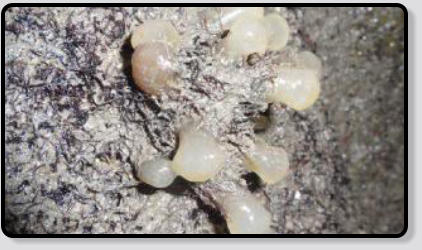Scientific classification
Kingdom:
Phylum:
Chordata
Class:
Ascidiacea
Order:
Phlebobranchia
Family:
Ascidiidae
Genus:
Ascidia
Species:
A. Mentula
Binomial name (link Wikipedia)




Smooth Sea Squirt
Ascidie
Glatte Weisse Seescheide
Ascidia
Gestipte Zakpijp

Description
Ascidia mentula is a species of solitary tunicate. It is found in the north east Atlantic Ocean, the Mediterranean Sea and Black Sea. It occurs
round the coasts of Britain but is seldom seen on the east coast of England or Scotland.
Ascidia mentula has a tough leathery envelope or tunic composed partly of cellulose. The translucent tunic encloses a fluid-filled body with
irregular bulges and two inconspicuous siphons. It is 5 to 18 cm (2 to 7 in) tall, bottle or flask-shaped with the oral (inlet) siphon at the tip and the
six-lobed atrial siphon half to two thirds of the way down. The oral siphon has six to eight, often white-tipped, lobes and is surrounded by up to
100 branchial tentacles. It is usually red, pink or sometimes olive green in colour, and may be grey in deep water. It normally adheres to the
substrate by the side opposite the atrial siphon.
Ascidia mentula is native to the north eastern Atlantic Ocean, its range extending from Norway southwards to the Mediterranean Sea and Black
Sea. It occurs on rocky substrates at depths ranging from subtidal down to 200 metres (660 ft).[2] It favours crevices and shady gullies and
sometimes adheres to Laminaria holdfasts, stones and shells.

Animalia
Scientific classification
Kingdom:
Phylum:
Chordata
Class:
Ascidiacea
Order:
Aplousobranchia
Family:
Clavelinidae
Genus:
Clavelina
Species:
C. Lepadiformis
Binomial name (link Wikipedia)




Bulb Tunicate
Claveline
Keulenascidie
Clavelina
Heldere Zakpijp

Description
Clavelina lepadiformis, common name the light-bulb sea squirt, is a colonial sea squirt native to the NE Atlantic Ocean.
The transparent tunic and visible yellow or white internal organs give this animal its common name.
This species is a common shallow-water ascidian in Great Britain and Ireland. It occurs from Norway along European coasts south to the
Mediterranean. In the Mediterranean the presence of cryptic species has been demonstrated.
Animalia
Scientific classification
Kingdom:
Phylum:
Chordata
Class:
Ascidiacea
Order:
Aplousobranchia
Family:
Aplousobranchia
Genus:
Na.
Species:
Eudistoma Sp
Eudistoma Sp.
Binomial name




Eudistoma Sp.
Eudistoma Sp.
Eudistoma Sp.
Eudistoma Sp.
Eudistoma Sp.

Description
No further information available on Wikipedia.
Animalia
Scientific classification
Kingdom:
Phylum:
Chordata
Class:
Ascidiacea
Order:
Pleurogona
Family:
Pyuridae
Genus:
Halocynthia
Species:
M. Papillosa
Binomial name (link Wikipedia)




Smooth Red Sea Squirt
Halocynthia papillosa
Halocynthia papillosa
Ascidia
Rode Zakpijp

Halocyntia papillosa, also known as the red sea squirt is a sea peach or sea squirt, a species of tunicate.
Halocynthia papillosa is usually about 10 cm high but can reach 20 cm. It can contract when disturbed.
This species occurs at depths of 2 to 100 metres It attaches itself to rocks and overhangs, or among Posidonia. It can be found in the Northeast
Atlantic, Western Pacific, along the Portuguese coast, and the Mediterranean.
Description
Animalia
Scientific classification
Kingdom:
Phylum:
Chordata
Class:
Thaliacea
Order:
Pyrosomida
Family:
Pyrosomidae
Genus:
Pyrosoma
Species:
P. Atlanticum
Binomial name (link Wikipedia)




Fire Rollers
Pirosomides
Feuerwalze
Pirosómidos
Pyrosome

Pyrosoma atlanticum is a pelagic species of marine colonial tunicate in the class Thaliacea found in temperate waters worldwide. The name of
the genus comes from the Greek words pyros meaning 'fire' and soma meaning 'body', referring to the bright bioluminescence sometimes
emitted.The specific epithet atlanticum refers to the Atlantic Ocean, from where the first specimen of the species was collected for scientific
description; it was described in 1804 by François Péron, a French naturalist.
A colony of P. atlanticum is cylindrical and can grow up to 60 cm (2 ft) long and 4–6 cm wide. The constituent zooids form a rigid tube, which may
be pale pink, yellowish, or bluish. One end of the tube is narrower and is closed, while the other is open and has a strong diaphragm. The outer
surface or test is gelatinised and dimpled with backward-pointing, blunt processes. The individual zooids are up to 8.5 mm (0.3 in) long and have
a broad, rounded branchial sac with gill slits. Along the side of the branchial sac runs the endostyle, which produces mucus filters. Water is
moved through the gill slits into the centre of the cylinder by cilia pulsating rhythmically. Plankton and other food particles are caught in mucus
filters in the processes as the colony is propelled through the water. P. atlanticum is bioluminescent and can generate a brilliant blue-green light
when stimulated.
P. atlanticum is found in temperate waters in all the world's oceans, usually between 50°N and 50°S. It is most plentiful at depths below 250 m
(800 ft). Colonies are pelagic and move through the water column.
Description
Animalia
Scientific classification
Kingdom:
Phylum:
Chordata
Class:
Thaliacea
Order:
Pyrosomida
Family:
Salpida
Genus:
Doliolida
Species:
Thaliacea
Binomial name (link Wikipedia)




Salp
Salpe
Salpe
Salpa
Salpen

The Thaliacea comprise a class of marine animals within the subphylum Tunicata. Unlike their benthic relatives the ascidians, thaliaceans are
free-floating (pelagic) for their entire lifespan. The group includes species with complex life cycles with both solitary and colonial forms.
Description
Animalia





Harry van Goor 2016
source: Wikipedia, the free encyclopedia


Categories: Sea squirts, Tunicates & Parasite






Scientific classification
Kingdom:
Phylum:
Arthropoda
Class:
Malacostraca
Order:
Isopoda
Family:
Cymothoidae
Genus:
Nerocila
Species:
N. Armata
Nerocila Armata
Binomial name




Large Parasitic Isopod
Nerocila Armata
Nerocila Armata
Piojo - Cochinillla
Grote Zeepissebed

Nerocila armata is a species of Parasitic in the family Cymothoidae. The scientific name of the species is valid for the first time published in 1853
by Dana.
No further information available on Wikipedia.
Description
Animalia


Scientific classification
Kingdom:
Phylum:
Arthropoda
Class:
Malacostraca
Order:
Stomatopoda
Family:
Pseudosquillidae
Genus:
Pseudosquilla
Species:
P. oculata
Pseudosquilla Oculata
Binomial name




Pseudosquilla Oculata
Pseudosquilla Oculata
Pseudosquilla Oculata
Pseudosquilla Oculata
Pseudosquilla Oculata

No further information available on Wikipedia.
Description
Animalia

